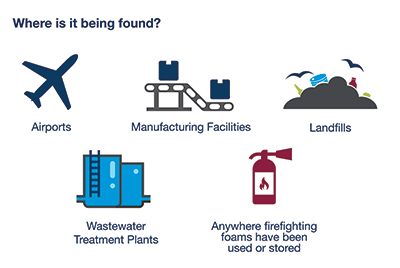PFAS and Brownfield Redevelopment: Risk Management

We had the opportunity to offer underwriting expertise as a panelist at the Pennsylvania Brownfields Conference, providing insight on the types of environmental insurance policies available and how underwriters are approaching the rising concerns of PFAS.
What are PFAS1 ?
Panel Discussion1:
As new risk-based research appears, contending that at least some PFAS compounds or strands of PFAS compounds may be more dangerous to health or the environment than previously suspected, the determination of remedial standards remains uncertain.
Nationally, class action lawsuits involving PFAS have multiplied in the last decade. These lawsuits have sought medical monitoring and damages for personal injury and property damage. Other lawsuits have sought to recover the cost of treating water contaminated by PFAS. Even without litigation pending or threatened, and even without a definite regulatory regime established, PFAS can present a major transactional risk. If not recognized and managed, this risk can result in exorbitant liabilities.
The panel discussed what PFAS are and how they have been used; current and proposed regulatory standards; the risks of litigation PFAS poses; the risk transactions face; and how these risks may be mitigated by insurance. Attention was given to how both Act 2 – Pennsylvania’s brownfields statute – and Pennsylvania’s constitution can be used to protect against certain liabilities created by PFAS contamination.
Topics Shared:
Where are PFAS found?
As mentioned in a previous Environmental Insider article , early formulations of PFAS have been produced in industrial quantities since the 1940s. Updated PFAS containing firefighting foam, also known as Aqueous Film Forming Foam (AFFF,) were introduced in the 1960s, pushing out earlier non-PFAS versions of AFFF. Today, due to their superior properties and effectiveness in extinguishing large jet fuel fires, PFAS AFFF systems are required by the FAA at commercial airports for firefighting. In addition to firefighting AFFF, PFAS has been detected in military, aerospace, automotive, construction, and electronics sites. Other areas include landfills, wastewater treatment discharges, bio solids and manufacturing facilities.
Is PFAS “Killing” Insurance Transactions?
Have you seen transactions fall apart because of PFAS concerns, or have carriers been able to negotiate coverage for these sort of accounts?
Although not common, we have experienced accounts that have almost fallen through as a result of not being able to offer PFAS coverage. In some cases, lenders or investors will require not including restrictions on policies as part of the transactions. The majority of the time, issues related to these sort of transactions are caused by a lack of site information available – by not receiving the appropriate documentation. It’s difficult for carriers to determine which applicable coverage should be offered for a property.
However, Great American Environmental specializes in custom coverage that is tailored to fit the changing needs of emerging contaminants. For these type of PFAS-related transactions, once additional site information is received, our team of experienced underwriters and dedicated technical support staff are able to craft a solution to offer coverage.

Landowner Liability Protections – Comprehensive Environmental Response, Compensation and Liability Act (CERCLA)
Under CERCLA the following protections are afforded for property owners:
Bona Fida Prospective Purchasers (BFPPs): Purchase property with knowledge of historic on-site contamination
Innocent landowners (ILOs): Purchase property without knowledge of historic on-site contamination, but historic contamination is later identified
Contiguous Property Owners (CPOs): Purchase property without knowledge of contamination on-site emanating solely from an adjacent property, but contamination is later identified
The problem is CERCLA pertains to Hazardous Substances, and as of today PFAS is not considered a hazardous substance.
What insurance policies are available, and do these policies provide coverage for unknown hazards? What kinds of properties are typically covered under these types of policies?
In today’s market, there are several types of environmental policies available for this type of coverage, including pollution legal liability – most commonly known as site pollution policies. Typically, the type of sites covered under these sort of environmental policies can range from commercial and residential properties to manufacturing facilities.
A Premises Environmental Liability (PRE) policy from Great American Environmental provides protection against true unknown environmental liability resulting from pollution conditions associated with a covered location, including: Bodily injury, property damage, legal expenses and clean-up costs. Typically, known conditions would be excluded from these types of pollution policies, and true unknown coverage can be offered.
This being said, with our ability to tailor policies, there are instances where we can provide custom coverage to help meet the insured’s needs. For example, there may be a known condition onsite, but the data supports that a plume may be isolated or controlled onsite. In this instance, we would potentially be able to offer offsite coverage.
Proposed Regulatory Standards (Or Lack Thereof!)
Unfortunately, there are currently no Federal Maximum Contaminant Levels (MCLs) or Pennsylvania promulgated standards in place for PFAS. This isn’t the first time this has occurred – many compounds today do not have Federal MCL’s. Methyl tert-butyl ether (MTBE) for example, which is a gasoline additive used as an oxygenate to raise octane number, has some of the same characteristics as PFAS: Highly soluble, little vapor risk, found in many potable wells and doesn’t particularly like to adhere to soils.
How are insurance companies looking at PFAS? What type of information is needed for underwriters to be able to offer coverage for a property?
As the requirement for sampling becomes more common, insurance companies are looking at PFAS like any other pollutant. Typically the information needed to examine PFAS includes phase I reports, which helps evaluate the background or history of the site to gain an understanding of the types of substances or chemicals used in historic operations.
If PFAS were suspected to be used historically on the site, it would most likely be excluded from coverage where subsurface data is not available. Phase II or subsurface investigations are also helpful in characterizing any environmental impacts on a property. It is also possible to get creative with certain coverages if there are contracts in place where risk is being transferred to another party.
On Feb 15, 2020, the PA Bulletin proposed standards for PFOA, PFOS and PFBS. Under current traditional insurance policies, for property owners or developers, would promulgating new standards affect these potential policies?
Under current policies, coverage may have been offered for certain pollutants as the concentrations in the subsurface met the standards at the time the policy was put in place. However, as standards change over the years, coverage could be triggered if a case is being re-opened or further scrutinized by a regulatory agency due to the new standards – this is also the case with emerging contaminants. Older environmental policies will not always exclude emerging contaminants, as the information may not be available at the time the policy was put in place. This being said, as new issues arise, policies may respond so as insureds potentially become legally obligated to address some emerging contaminants.
Real Estate Transactions – Defining Risk
Can environmental insurance lessen the risks associated with PFAS exposure?
As an insured, risk exposure can be lessened or mitigated through purchasing environmental insurance. However, as an insurance carrier we would have to determine what coverage can be offered. As mentioned earlier, subsurface information and other environmental reports are important to help evaluate and tailor coverage to the insured’s needs. As standards change and new contaminants come to light, purchasing environmental insurance could be crucial for mitigating risk.
While environmental issues may be more infrequent, when they do occur, they are often massive, expensive and complex.
Consider the following scenario:
 An insured manufacturer – located in an industrial region with many other manufacturers – has been sued by a municipality that claims its drinking water supply was contaminated with PFAS as a result of the manufacturer’s operations. To address the PFAS damage, the municipality demanded material compensation be paid for clean-up costs as well as installation fees to upgrade its water treatment system. Although the insured manufacturer asserted that it did not use or involve any PFAS chemicals in its processes, unfortunately, extensive legal expenses to defend against litigation were incurred.
An insured manufacturer – located in an industrial region with many other manufacturers – has been sued by a municipality that claims its drinking water supply was contaminated with PFAS as a result of the manufacturer’s operations. To address the PFAS damage, the municipality demanded material compensation be paid for clean-up costs as well as installation fees to upgrade its water treatment system. Although the insured manufacturer asserted that it did not use or involve any PFAS chemicals in its processes, unfortunately, extensive legal expenses to defend against litigation were incurred.
Obtaining a policy with Great American Environmental Division can help mitigate environmental protection concerns by providing a clear, consistent and competitive site policy. When your clients need responsive insurance services, you can count on us to deliver tailored solutions, fast.
Sampling & Analysis Data Validity
Current standards for analyzing PFAS are adopting drinking water procedures for non-drinking water and other media such as soils, sediment and air. In addition, laboratories have developed their individual “modification” procedures to be analyses for other media content and to expand the number of PFAS substances reported
How do you see this potentially impacting insurance companies and policies that have been in place or are being written today?
For policies that are currently in place, sampling for PFAS or other future emerging contaminants may be required as more information about these contaminants becomes available, and the insured becomes legally obligated to further remediate his or her property. For policies being considered now, carriers may be hesitant to offer full coverage for PFAS or other emerging contaminants while knowing there may have been historic use of those substances in the past. As mentioned above, carriers most likely will request additional information in order to get more comfortable with offering certain coverage.
It is important to trust in a carrier who proactively evaluates the impact of new environmental regulations and emerging contaminants. Within such an ever-changing market, Great American Environmental continues to monitor proposed regulations as well as state and federal initiatives, to proactively adapt to emerging concerns. With effective underwriting, mitigation of unknowns in coverage and creative solutions, we are confident that our experience and expertise will allow us to respond and appropriately manage risks.
Contact your underwriter today to learn more about how our core products and services can help you protect your client’s operations.


Olivia Sarkisian, Production Underwriting Supervisor
Great American Environmental Division
Olivia Sarkisian is a Production Underwriting Supervisor with Great American’s Environmental Division. She obtained a Bachelor of Science in chemical engineering and a Master of Science in environmental engineering from Manhattan College. While at Manhattan College, she performed surface water quality monitoring as part of a research grant, analyzing parameters such as fecal coliform, total phosphorus, pH, turbidity, metals, conductivity and ammonia. Prior to Great American, Olivia worked for an engineering and environmental service consulting company. During her tenure, she focused on remedial site investigations and implementation of remedial activities. She is based out of the New York office.
Reference: